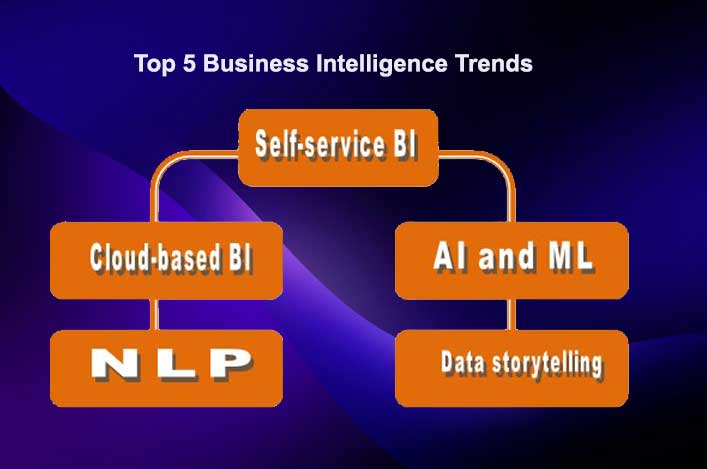Top 5 Business Intelligence Trends: Shaping the Future of Data-driven Decision Making
Business Intelligence (BI) is continually evolving to meet the ever-changing needs and challenges of the modern business landscape. Here are the top five trends shaping the future of BI and data-driven decision-making:

1. Augmented Analytics:
Definition: Augmented analytics integrates artificial intelligence (AI) and machine learning (ML) algorithms into BI tools to automate data preparation, analysis, and insights generation.
Benefits: Augmented analytics enhances the speed and accuracy of data analysis, enabling users to uncover hidden patterns, trends, and insights with minimal manual effort.
Impact: By automating repetitive tasks and empowering users with advanced analytical capabilities, augmented analytics democratizes access to data-driven insights across the organization, driving informed decision-making at all levels.
2. Self-Service BI:
Definition: Self-service BI empowers business users to access, analyze, and visualize data independently without relying on IT or data analysts.
Benefits: Self-service BI enhances agility and flexibility by enabling users to explore data and generate insights on-demand, reducing dependency on IT resources and accelerating decision-making processes.
Impact: By democratizing access to data and analytics capabilities, self-service BI fosters a culture of data-driven decision-making throughout the organization, empowering users to make informed choices based on real-time insights.
3. Data Governance and Privacy:
Definition: Data governance encompasses policies, processes, and controls for managing and protecting data assets to ensure accuracy, integrity, and compliance with regulatory requirements.
Benefits: Strong data governance practices promote trust and confidence in data quality, security, and privacy, mitigating risks and enhancing organizational transparency and accountability.
Impact: With increasing concerns about data privacy and regulatory compliance, organizations are prioritizing investments in data governance frameworks and technologies to safeguard sensitive information and maintain regulatory compliance.
4. Cloud-based BI Solutions:
Definition: Cloud-based BI solutions leverage cloud infrastructure and services to deliver scalable, flexible, and cost-effective analytics capabilities to organizations of all sizes.
Benefits: Cloud-based BI solutions offer rapid deployment, scalability, and accessibility, enabling organizations to access and analyze data from anywhere, anytime, using any device.
Impact: As businesses embrace digital transformation and remote work trends, cloud-based BI solutions provide the agility and flexibility needed to adapt to changing business environments and support distributed teams.
5. Embedded Analytics:
Definition: Embedded analytics integrates BI capabilities directly into business applications, workflows, and processes, allowing users to access and interact with data within the context of their daily activities.
Benefits: Embedded analytics enhances user productivity and decision-making by embedding insights directly into business applications, eliminating the need to switch between multiple tools and systems.
Impact: By embedding analytics into operational workflows and customer-facing applications, organizations can drive user adoption, improve data literacy, and deliver differentiated experiences to customers and stakeholders.
Conclusion:
These top five BI trends—augmented analytics, self-service BI, data governance and privacy, cloud-based BI solutions, and embedded analytics—are shaping the future of data-driven decision-making by empowering organizations to extract actionable insights, enhance agility, and drive innovation. As businesses navigate a rapidly evolving digital landscape, embracing these trends will be essential to stay competitive, adapt to change, and capitalize on emerging opportunities in the era of data-driven business intelligence.